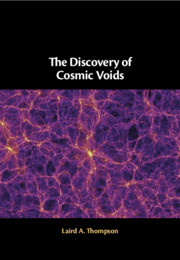Book contents
- The Discovery of Cosmic Voids
- The Discovery of Cosmic Voids
- Copyright page
- Dedication
- Contents
- Foreword
- Preface
- Acknowledgments
- Abbreviations
- 1 Understanding the Foundations of Modern Cosmology
- 2 Preview of the Discovery of Cosmic Voids
- 3 Homogeneity of the Universe: Great Minds Speak Out
- 4 All-Sky Surveys in the Transition Years 1950–1975
- 5 The Early Redshift Surveys from Arizona Observatories
- 6 Galaxy Mapping Attempt at Tartu Observatory
- 7 Theoretical Models of Galaxy Formation – East versus West
- 8 Priority Disputes and the Timeline of Publications
- 9 Impact of Cosmic Voids: Cosmology, Gravity at the Weak Limit, and Galaxy Formation
- Book part
- Notes
- Biographical Sketches
- References
- Index
7 - Theoretical Models of Galaxy Formation – East versus West
Published online by Cambridge University Press: 02 December 2020
- The Discovery of Cosmic Voids
- The Discovery of Cosmic Voids
- Copyright page
- Dedication
- Contents
- Foreword
- Preface
- Acknowledgments
- Abbreviations
- 1 Understanding the Foundations of Modern Cosmology
- 2 Preview of the Discovery of Cosmic Voids
- 3 Homogeneity of the Universe: Great Minds Speak Out
- 4 All-Sky Surveys in the Transition Years 1950–1975
- 5 The Early Redshift Surveys from Arizona Observatories
- 6 Galaxy Mapping Attempt at Tartu Observatory
- 7 Theoretical Models of Galaxy Formation – East versus West
- 8 Priority Disputes and the Timeline of Publications
- 9 Impact of Cosmic Voids: Cosmology, Gravity at the Weak Limit, and Galaxy Formation
- Book part
- Notes
- Biographical Sketches
- References
- Index
Summary
Two models of galaxy formation were being investigated simultaneously on the 1970’s. The bottom-up model was championed by Peebles, and the top-down model by Zeldovich. At first, dark matter was not part of either model, but this effort to explain the origin of galaxies eventually stalled for both models the because the temperature fluctuations in the cosmic background radiation are too small to accommodate galaxy formation from baryons alone. At first massive neutrinos were introduced as dark matter, and when this failed to word, cold dark matter (CDM) was introduced. CDM forms early halos, and then baryons eventually fall into these halos. The first CDM computer models of galaxy formation were introduced by Melott and Shandarin and later developed by the “Gang of Four” (White, Davis, Efstathiou and Frenk). Eventually, the top-down and bottom-up models gracefully merged, and the concept of “biasing” became part of the final model.
Keywords
- Type
- Chapter
- Information
- The Discovery of Cosmic Voids , pp. 134 - 157Publisher: Cambridge University PressPrint publication year: 2020

